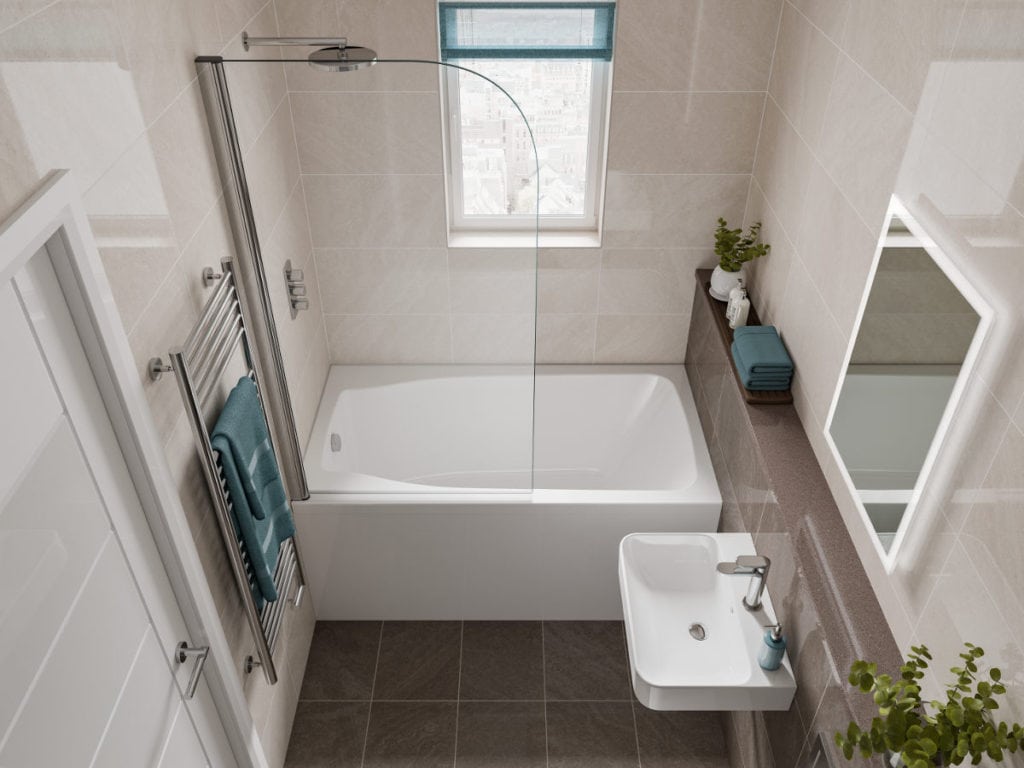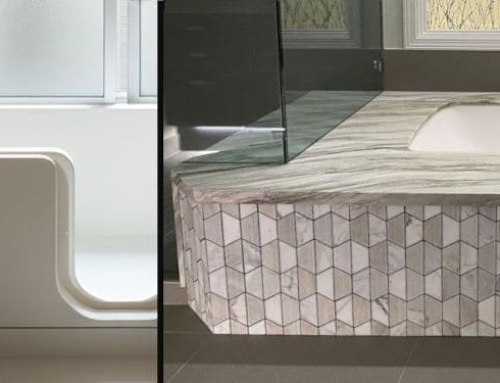Why a Small Bathroom Needn’t Mean Dispensing with the Bath …
Small bathrooms have become much more common in recent years and, partly, that’s the result of growing demand for small en-suite bathrooms.
Recognising this, house developers are increasingly designing new homes with one or more small bathrooms already built in. Other small bathrooms are the result of home improvement projects. Often, home-owners will add a partition wall in an existing bedroom to create a separate en-suite; others will take an existing cloakroom or utility room and convert it into a bathroom.
For many of these small rooms, ‘bathroom’ is something of a misnomer because the bath itself is missing. Faced with a relatively confined space, many people assume that their only options are a shower cubicle or a wet room. However, for all but the tiniest spaces, baths are still an option – just not the conventional, trough-shaped ones that people most commonly imagine.
Lateral Thinking
Perhaps the single most important consequence of a purposely-designed small bath is that it affords the option to set it across the room, rather than against one of the long walls. It’s a design choice that simply doesn’t occur to many people when remodelling their bathrooms. This is usually because they have a mental picture of what the minimum length of a bath must be.
If that mental picture assumes that a bath must be around 6 feet (1820mm) in length, then of course the idea of installing the bath between the two long walls will never occur. However, there are much shorter baths that make this sort of installation completely feasible. By substituting depth for length, they offer new layout options, and they still remain exceptionally comfortable. The bathing posture is different – more like the seated position adopted in a Japanese-style deep soaking tub – but most of those who have tried such baths actively prefer the experience.
The Calyx deep soaking tub is a good example. It comes in two lengths: 1230 and 1440mm (48.5 or 56.75 inches) so it can fit conveniently into very restricted spaces, as illustrated in the first two examples shown below:

From left to right: a Calyx in a converted shower room; another Calyx in a newly remodelled small bathroom; and a Nirvana soaking tub, fitted with a hydrotherapy system as part of a narrow bathroom refurbishment.
In all these cases, it would have been impractical to install a traditional bath lengthways along the wall. There would have been insufficient space between the bath’s edge and the WC. In such cases, setting a small bath against the back wall is often the only practical way to include a bath within the overall design.
Best Use of Space
Fitting a bath squarely across the far end of a bathroom leaves the majority of the floor space unrestricted. It also ensures there is no dead space left in corners or gaps between fittings. It is sometimes possible to fit a small oval bath diagonally into a corner of a narrow bathroom, but this leaves the floor behind it inaccessible. This wastes space and can risk creating a dust trap that is difficult to clean. A small rectangular bath will invariably make best use of the available space.
Small Baths for Small Bathrooms
Deep soaking tubs have gained massively in popularity since Cabuchon/Design & Form launched the first one in 1991. Their eminent suitability for small bathrooms is a big reason for their success. However, they are not the only type of space-saving bath that can be considered.
There are numerous other space-saving baths that can’t be classified as deep soaking tubs. This is because they work more like conventional baths in terms of bathing posture. The bather sits relatively upright in a deep soaking tub, whereas he or she is much more reclined in a conventional space-saving bath.
The Studio is an example of one of these more conventional space-saving baths. Measuring just 5 feet in length (1522mm) it’s longer than many deep soaking tubs but still offers more design and layout options than a traditional six-footer.

The Studio, at 1522mm in length, is an example of a small, space-saving bath of a more traditional design.
Small Baths and Showers
There is no doubt that showering is part of 21st century living, so in a small bathroom, it might be important that the chosen bath can be used in conjunction with an overhead shower. In the example above, the Studio works well with a shower, and so too do many deep soaking tubs.
If the option to shower is important, then check that the chosen bath:
- Can be fitted with a shower screen
- Has enough space in the footwell to be safe and comfortable
This second point is important. A good deep soaking tub will be fitted with an inbuilt seat, and possibly with extra supports such as arm and foot-rests. These make for a much more comfortable bathing experience, but check that they don’t make the footwell too small or cluttered for safe showering.

In all these examples, the deep soaking tubs are shown with overhead showers and either hinged or folding shower screens.
Creative Storage
Storage can be a challenge in any small bathroom. There are of course the usual, obvious solutions, such as installing a cabinet under a hand basin, and affixing a bathroom cabinet to the wall, but there are other creative options that can help.
For example, if a bath is to be fitted into a raised surround, then consider whether that surround can also be fitted with drawers. Similarly, if you’ll need a step to access a deep bath, then could that step be built in, with storage space underneath?

An Imersa deep soaking tub installed in a bathroom in Tennessee, complete with a step for access and shelving / storage above the bath.
Other Small Bathroom Ideas
At Cabuchon, our expertise lies in designing and producing high quality baths, including deep soaking tubs and space-saving baths for small bathrooms. However, we have seen many of our clients apply some very useful design ideas, either to give the impression of more space, or to make the best use of the space that they have.
Some examples include:
- Installing under-floor heating, (removing the need for wall-mounted radiators / heaters);
- Fitting large (or multiple) mirrors to visually extend the boundaries of the room;
- Decorating with light colours to give bathrooms an airier feel;
- Using recessed downlights rather than pendants to maximise headroom;
- Using compact fittings elsewhere: e.g. slimline basins, WCs and cisterns.
Find Out More
Please see our ‘What Our Customers Say’ section for illustrated examples of some our customers’ own solutions to the challenges of small bathroom design.
For more details about our deep soaking tub range, please download our free PDF Guide to Choosing a Deep Soaking Tub.
If you would like any more help in choosing a compact bath for a small bathroom, please contact us.
You can also download this article, small-bathroom-ideas, as a PDF (477kb).





